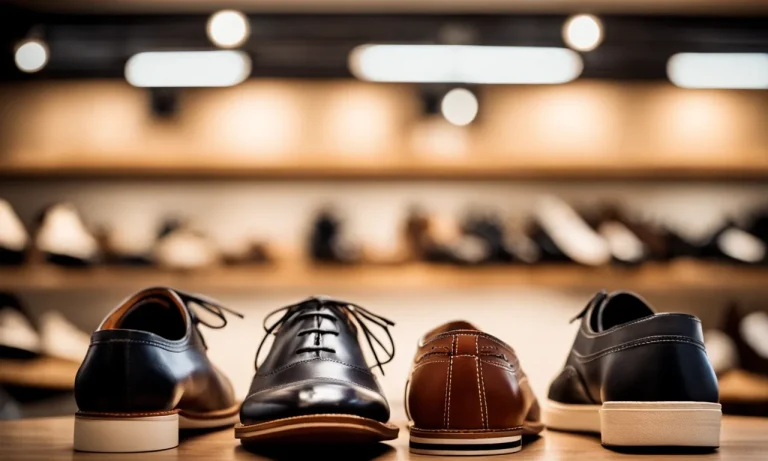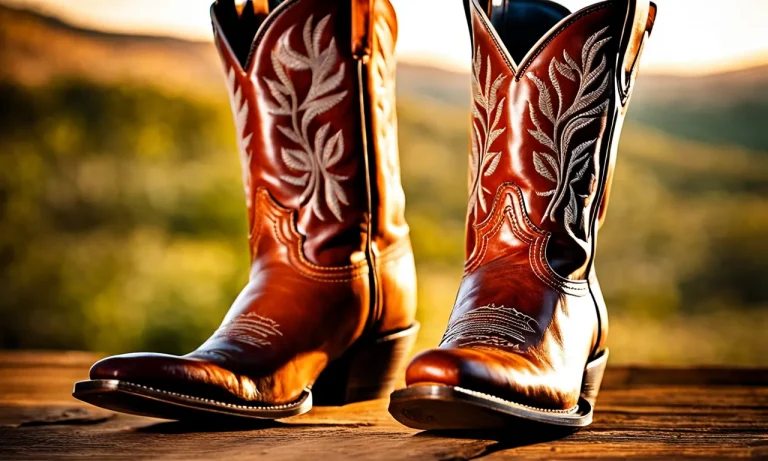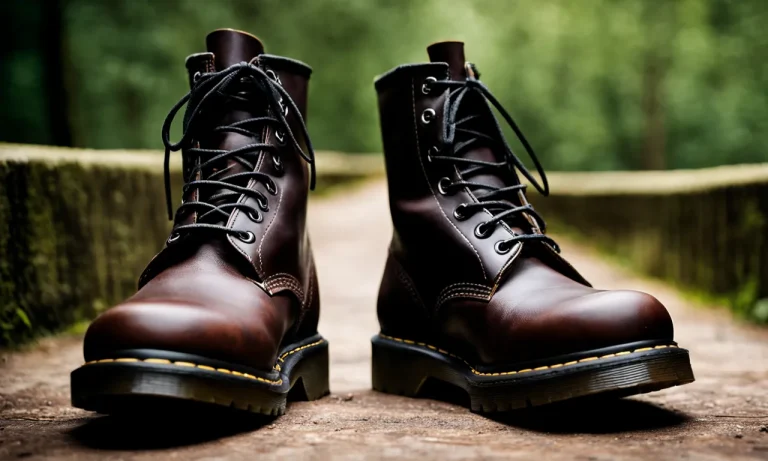If your favorite leather boots have started coming apart at the seams, you may be wondering what is the best leather glue to repair them. Using the right adhesive is crucial for getting a seamless, long-lasting bond.
If you’re short on time, here’s a quick answer to your question: Barge All-Purpose Cement is one of the top-rated leather glues for boots and shoes thanks to its strong, flexible bond and easy application.
In this comprehensive guide, we’ll go over the key factors to consider when shopping for leather boot glue. We’ll also provide leather glue reviews and recommendations for the best shoe repair adhesives on the market.
What to Look for in a Leather Glue
Flexibility
When choosing a leather glue for your boots, one of the most important factors to consider is its flexibility. Leather is a material that bends and flexes, so you need a glue that can withstand these movements without cracking or separating.
Look for a glue that is specifically designed for use on leather and offers a high level of flexibility. This will ensure that your boots stay intact and comfortable to wear, even with regular use.
Adhesion
Another crucial aspect to consider is the adhesive strength of the leather glue. You want a glue that forms a strong bond between the leather surfaces, ensuring that they stay securely attached. Look for a glue that is specifically formulated for use on leather and offers excellent adhesion properties.
This will give you peace of mind knowing that your boots will remain intact, even under heavy stress or strain.
Drying Time
The drying time of the leather glue is an important factor to consider, especially if you’re working on a time-sensitive project or need to wear your repaired boots as soon as possible. Some glues have quick-drying formulas that allow you to continue using your boots within a short period of time.
On the other hand, there are glues that require a longer drying time for a stronger bond. Consider your specific needs and choose a glue that aligns with your timeframe.
Ease of Application
Lastly, consider the ease of application when selecting a leather glue. Look for a glue that comes with a user-friendly applicator or nozzle, making it easy to apply the adhesive precisely where it’s needed.
Additionally, opt for a glue that doesn’t require extensive preparation or complex mixing processes. A straightforward and hassle-free application process will save you time and effort, allowing you to complete your project efficiently.
Remember, it’s always a good idea to read product reviews and customer feedback before making a purchase. This will give you valuable insights into the performance and reliability of different leather glues.
Additionally, consult with professionals or experienced leatherworkers for recommendations and advice. By considering these factors and doing your research, you can find the best leather glue for your boots and ensure a long-lasting and secure repair.
Reviews of the Best Leather Glues for Boots
Barge All-Purpose Cement
Barge All-Purpose Cement is a popular choice among professionals and DIY enthusiasts alike. This adhesive is specially formulated for bonding leather, rubber, and other materials. Its strong bond ensures that your boots will stay intact, even in harsh conditions.
Additionally, Barge All-Purpose Cement dries quickly, allowing you to get back to wearing your favorite boots in no time.
Gorilla Glue
Gorilla Glue is known for its versatility and strength, making it a reliable option for repairing leather boots. This adhesive expands as it dries, filling in any gaps or cracks and creating a strong bond.
Gorilla Glue is also water-resistant, ensuring that your boots will remain durable and long-lasting. Whether you need to fix a loose sole or mend a torn seam, Gorilla Glue is up to the task.
Loctite Ultra Gel Control Super Glue
Loctite Ultra Gel Control Super Glue is a top choice for those looking for a precise and mess-free application. Its gel formula allows for easy control, preventing any accidental spills or drips. This adhesive forms a strong bond quickly, ensuring that your boots will be ready for wear in no time.
Loctite Ultra Gel Control Super Glue is also resistant to water and impact, making it a reliable option for boot repairs.
E6000 Craft Adhesive
E6000 Craft Adhesive is a versatile glue that is suitable for various materials, including leather. This adhesive offers a strong and flexible bond, ensuring that your boots can withstand regular wear and tear.
With its clear and waterproof formula, E6000 Craft Adhesive is perfect for repairing boots without compromising their appearance. It also dries transparent, making it virtually invisible on your boots.
Shoe Goo Repair Adhesive
Shoe Goo Repair Adhesive is specifically designed for shoe repairs, including leather boots. This adhesive forms a strong, flexible bond that can withstand bending and twisting, making it ideal for fixing soles and heels.
Shoe Goo Repair Adhesive is also resistant to water and extreme temperatures, ensuring that your boots remain in great condition. Its easy-to-use applicator allows for precise and controlled application.
When choosing the best leather glue for boots, it’s important to consider the specific needs of your repair project. Whether you’re fixing a small tear or reattaching a sole, these top-rated glues are sure to get the job done effectively and efficiently.
How to Properly Glue Leather Boots
Repairing your beloved leather boots doesn’t have to be a daunting task. With the right techniques and the best leather glue, you can easily mend any damage and extend the life of your boots. Here is a step-by-step guide on how to properly glue leather boots:
Prepare the Leather
Before applying any adhesive, it is essential to properly prepare the leather surface. Start by cleaning the area around the damaged part using a mild leather cleaner and a soft cloth. This will remove any dirt, oils, or residue that could hinder the bonding process.
Allow the leather to dry completely before moving on to the next step.
Apply the Adhesive
Choosing the right adhesive is crucial for a strong and long-lasting bond. Look for a high-quality leather glue specifically designed for boots. Apply a thin, even layer of adhesive onto both surfaces that need to be glued together. Use a small brush or a cotton swab for precise application.
Make sure to follow the manufacturer’s instructions for the recommended drying time.
Clamp the Pieces Together
Once the adhesive is applied, carefully align the damaged parts and press them firmly together. To ensure a tight bond, use clamps or heavy objects to apply even pressure. This will prevent any gaps or bubbles from forming between the surfaces.
Leave the clamps in place for the recommended curing time specified by the adhesive manufacturer.
Let It Cure
After clamping the pieces together, it is important to let the glue cure undisturbed. This allows the adhesive to fully bond with the leather and ensures a strong hold. Avoid wearing or using the boots until the recommended curing time has passed.
This will give the adhesive enough time to reach its maximum strength and durability.
By following these steps and using the best leather glue for boots, you can effectively repair and maintain your leather footwear. Remember to always read and follow the instructions provided by the adhesive manufacturer for the best results.
Now you can confidently tackle any leather boot repair and enjoy your favorite pair for years to come!
Leather Glue vs Leather Sewing
When it comes to repairing or fixing leather items such as boots, two popular methods are often considered – using leather glue or sewing. Both methods have their advantages and disadvantages, and choosing the right one depends on the specific situation and personal preference.
Leather Glue
Leather glue is a convenient and efficient way to repair leather items. It is easy to use and can provide a strong bond if used correctly. Leather glue is especially useful for small repairs or fixing minor tears in leather boots. It can also be used to reattach detached soles or fix loose seams.
The glue dries quickly and creates a durable bond, making it a popular choice for many leather enthusiasts.
One of the main advantages of using leather glue is that it does not require any special skills or tools. It can be easily applied to the damaged area and left to dry. Leather glue also provides a seamless finish, as there are no visible stitches or thread marks.
Additionally, it is a cost-effective option compared to sewing, as it eliminates the need for thread, needles, and other sewing accessories.
However, it is important to note that leather glue may not be suitable for all types of leather or extensive repairs. Some types of leather may not bond well with glue, and the repair may not hold up over time.
It is also not recommended for repairing large tears or replacing entire sections of leather. In such cases, leather sewing may be a better option.
Leather Sewing
Leather sewing is a traditional and time-tested method of repairing leather items. It involves using a needle and thread to stitch the damaged area back together. Leather sewing provides a strong and durable repair, especially for larger tears or extensive damage.
It allows for flexibility and can withstand heavy use and stress.
One of the advantages of leather sewing is that it allows for more precise repairs. It allows you to control the tension and strength of the stitches, ensuring a secure and long-lasting repair. Leather sewing also maintains the original look of the item, as the stitches blend in with the leather and create a seamless finish.
However, leather sewing requires some skill and practice. It may not be suitable for beginners or those who are not comfortable with needlework. It also requires the use of specialized tools such as leather needles and waxed thread.
Leather sewing can be time-consuming, especially for complex repairs or intricate designs.
Leather Glue Tips and Precautions
Test on a Hidden Area First
Before applying leather glue to your boots, it is always recommended to test it on a hidden or inconspicuous area first. This allows you to check for any adverse reactions or discoloration that may occur. Simply apply a small amount of glue to the hidden area and let it dry.
If there are no negative effects, you can proceed with confidence knowing that the glue is safe to use on your boots.
Avoid Over-application
When using leather glue, it is important to avoid over-applying the adhesive. Using too much glue can result in messy and uneven bonding, which may affect the overall appearance and durability of your boots. Remember, a little goes a long way when it comes to leather glue.
Apply a thin, even layer and press the surfaces firmly together for the best results. If you do happen to apply too much glue, use a cotton swab or cloth to remove the excess before it dries.
Store at Room Temperature
Proper storage of your leather glue is crucial for maintaining its effectiveness. It is recommended to store your glue at room temperature in a cool, dry place. Extreme temperatures and humidity can negatively impact the adhesive properties of the glue, leading to reduced bonding strength.
By storing your leather glue correctly, you can ensure that it remains in optimal condition and ready to use whenever you need it.
Conclusion
When your favorite leather boots start coming apart, it can be tempting to just throw them out and buy a new pair. But with the right adhesive, you can often repair them for a fraction of the cost of replacements.
For the strongest, most flexible bond on leather boots, Barge Cement is a top choice. But glues like Gorilla Glue and Shoe Goo also have their advantages. Just be sure to read the directions carefully and properly prepare the leather before gluing.
With a quality leather boot glue and a little patience during drying time, your boots can look good as new again. Just take care not to over-apply the adhesive and be gentle as it cures. Your favorite boots will be ready to wear again in no time!






